New Mexico is a mother lode when it comes to fossils. According to research, the state’s fossil record is incredibly complete and highly frequent across the stratigraphic column. So far, over 3,300 unique fossil organisms have been found in New Mexico, out of which over 700 marked new scientific discoveries and over 100 eventually became type species for a variety of new genera.
The state’s fossil record begins in the Paleozoic period when a shallow sea covered the New Mexico region. The Carboniferous period then marks the appearance of a vegetated island from the aforementioned sea. While the underwater environments experienced the development and growth of coral reefs, the freshly risen islands would dry up and turn into dunes.
From Late Triassic, New Mexico was also introduced to dinosaurs – about eight species were identified here with the help of fossils. Let’s learn more about them!
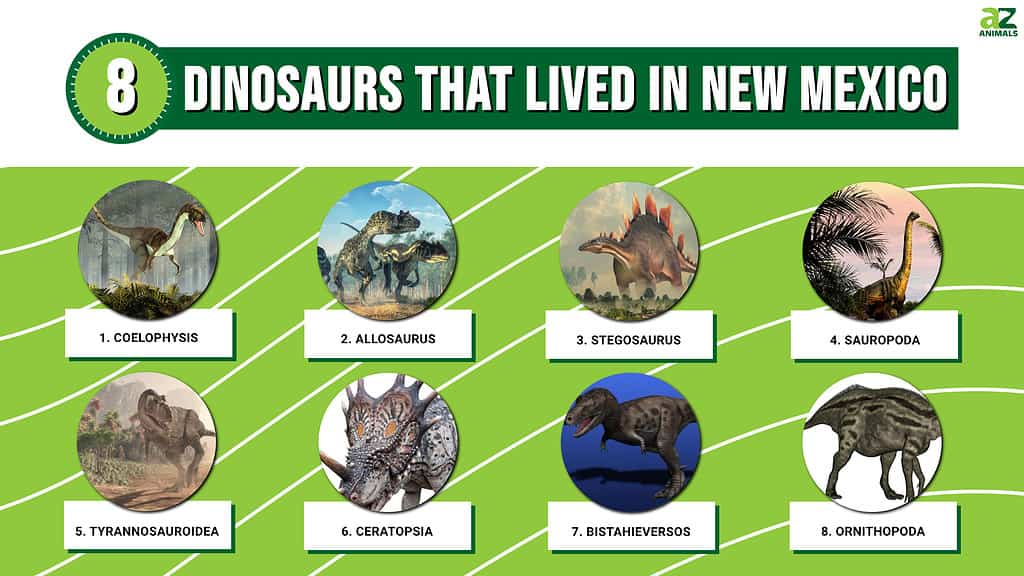
8 Dinosaurs That Lived in New Mexico
New Mexico is known as the home of one of the earliest dinosaurs, Coelophysis, that inhabited the region during the Late Triassic period alongside the rare Prosauropods. The Early and Middle Jurassic periods are not that well known, probably due to the lack or abundance of fossils. The Late Jurassic, however, is the period that hosted other dinosaurs like Stegosaurus, Allosaurus, and multiple sauropod species.
1. Coelophysis
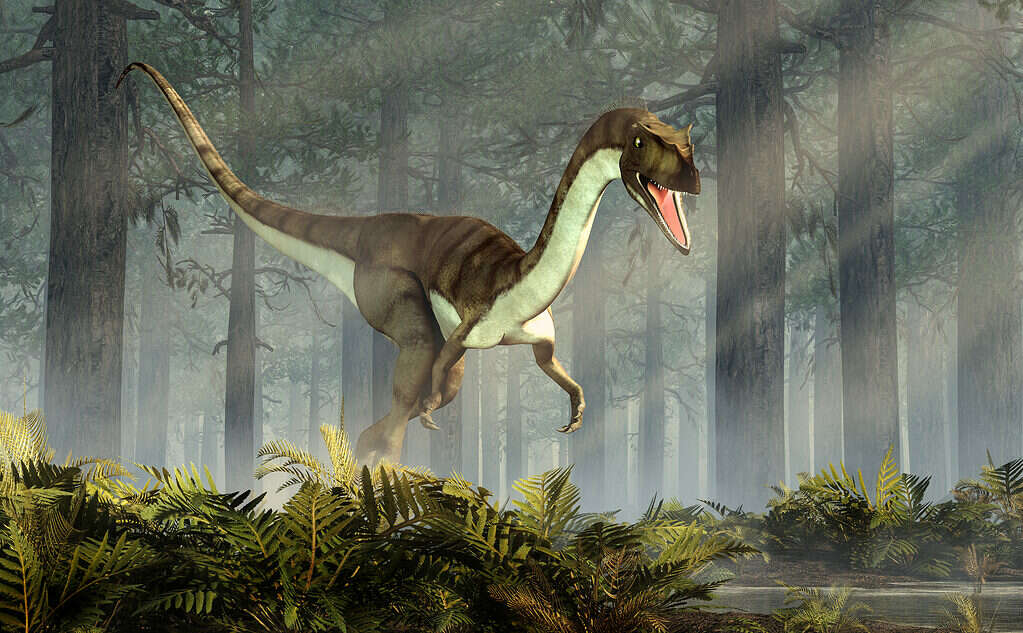
could grow up to 9.8 feet (3 m) long.
©Daniel Eskridge/Shutterstock.com
Present in New Mexico during the Late Triassic period (specifically from the Carnian to the Rhaetian stages), about 228 to 201.3 million years ago, Coelophysis is one of the earliest dinosaur genera known to man. It is characterized as slenderly-built, small, and dwelling mainly on the ground. Despite this, Coelophysis was a predator, specifically a bipedal carnivore.
Coelophysis was half the height of a modern human but could grow up to 9.8 feet (3 m) long. Regarding weight, experts suggest that slender specimens weighed about 33 lbs (15 kg), while those with a robust build weighed about 44 lbs (20 kg).
The genus’ type species, C. bauri, is known for having the earliest known example of a wishbone in a dinosaur.
2. Allosaurus
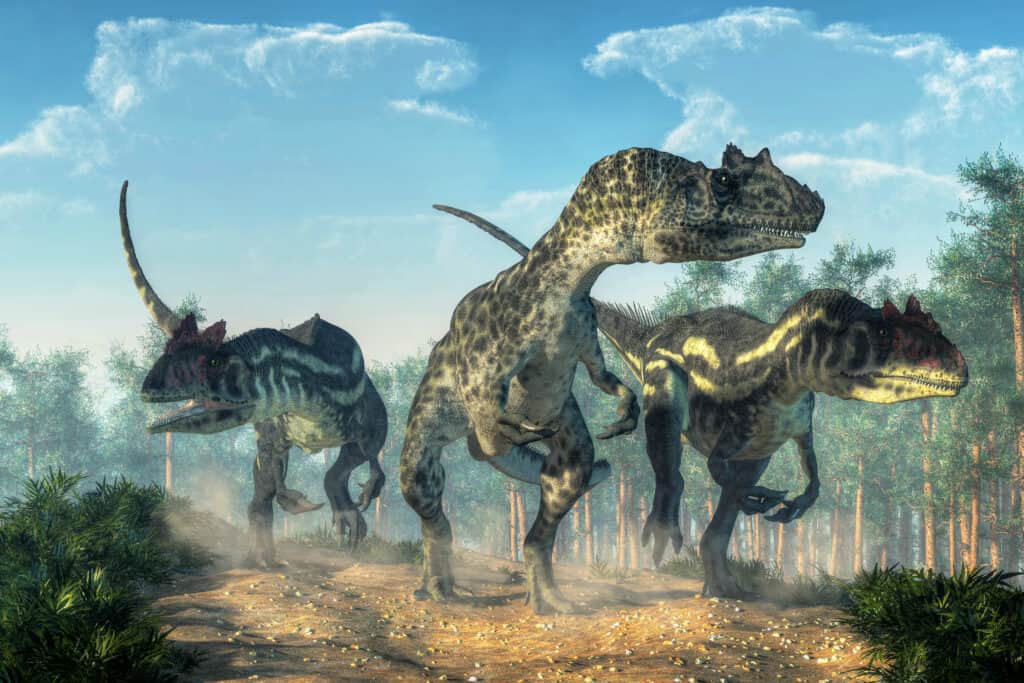
is a representative of the clade
Theropodaof hollow-boned dinosaurs.
©Daniel Eskridge/Shutterstock.com
Present in New Mexico during the Late Jurassic period (specifically from the Kimmeridgian to the Tithonian), about 155 to 145 million years ago, Allosaurus is a representative of the clade Theropoda of hollow-boned dinosaurs. The clade is also known for having three toes and three claws on each limb. The translation of the term “Allosaurus” means different lizard. The name was given to mark the unique concave vertebrae this new genus sported at the time of discovery.
Allosaurus was a predator that could grow up to 28 feet (8.5 m) long. The largest specimens in the genus could reach lengths of up to 43 feet (13 m). These large dinosaurs weighed about 1.9 short tons (1.7 metric tons), but the value varies between species.
3. Stegosaurus

is a representative of the
Ornithischiaorder of bird-hipped dinosaurs.
©Daniel Eskridge/Shutterstock.com
Present in New Mexico during the Late Jurassic period (specifically from the Kimmeridgian to the Tithonian), about 155 to 145 million years ago, Stegosaurus is a representative of the Ornithischia order of bird-hipped dinosaurs. Translated as “roof lizards,” Stegosaurus is a well-known type of dinosaur, being showcased in many movies. It is characterized as an armored dinosaur thanks to its kite-shaped plates located along its back.
One of the three Stegosaurus species, S. ungulatus, could grow up to 23 feet (7 m) long and weigh about 4.2 short tons (3.8 metric tons). Regarding height, the information we have pertains to a specimen yet to reach adulthood; it was about 6.6 feet (2 m) tall. However, research suggests that S. ungulatus could grow two times taller than a modern human (including the armored plates on top of his back).
4. Sauropoda
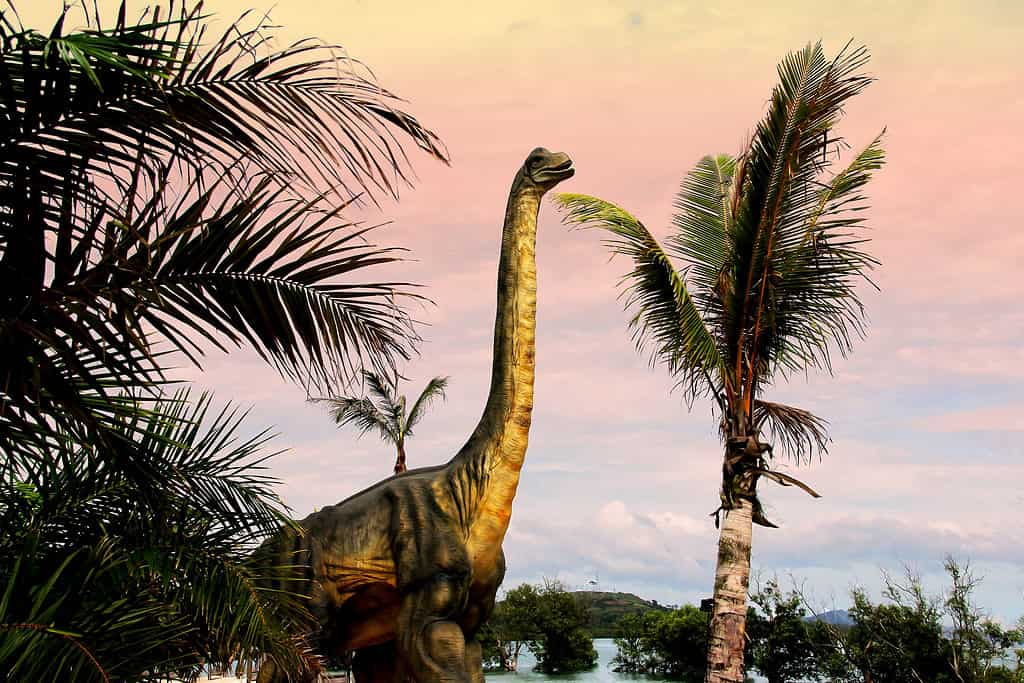
Sauropods are characterized by long tails, long necks, and small heads.
©thaloengsak/Shutterstock.com
Present in New Mexico during the Late Triassic and Late Cretaceous periods, about 228 to 66 million years ago, the Sauropoda are representatives of the Saurischia clade of lizard-hipped dinosaurs. Their scientific name translates to “lizard-footed.”
Sauropods are characterized by long tails, long necks, and small heads. Their legs are often referred to as pillar-like. This is partly due to the fact that they were able to support the size of this massive dinosaur.
Speaking of massive, the Sauropoda clade features some of the largest dinosaurs of the time. According to research, even dwarf specimens could grow up to 20 feet (5.6 m) long. The longest sauropod was the Supersaurus, which had a length of 108-112 feet (33-34 m).
Reportedly, their tails were so long and so powerful that sauropods could crack them like a whip. This created a sonic boom, scaring away most, if not all, potential predators.
5. Tyrannosauroidea

are characterized by constant evolution, especially when it comes to size
©iStock.com/Orla
Present in New Mexico and other parts of the North American land during the Middle Jurassic and Late Cretaceous periods, about 166 to 66 million years ago, Tyrannosauroidea are representatives of the Theropoda clade of hollow-boned dinosaurs. With its type species, Tyrannosaurus rex, this superfamily dominated the dinosaur world by the end of the Cretaceous; they were among the largest and fiercest predators around.
Tyrannosauroids are characterized by constant evolution, especially when it comes to size. One of the smallest species of this superfamily, the Dilong, could grow as long as 5.3 feet (1.6 m), while the Tyrannosaurus would grow longer than 39 feet (12 m).
According to research, during their 100-million-year temporal range, tyrannosaurs were small or medium-sized for the first 80 million years. Still, they evolved into some of the largest terrestrial predators of all time in the last 20 million years.
6. Ceratopsia
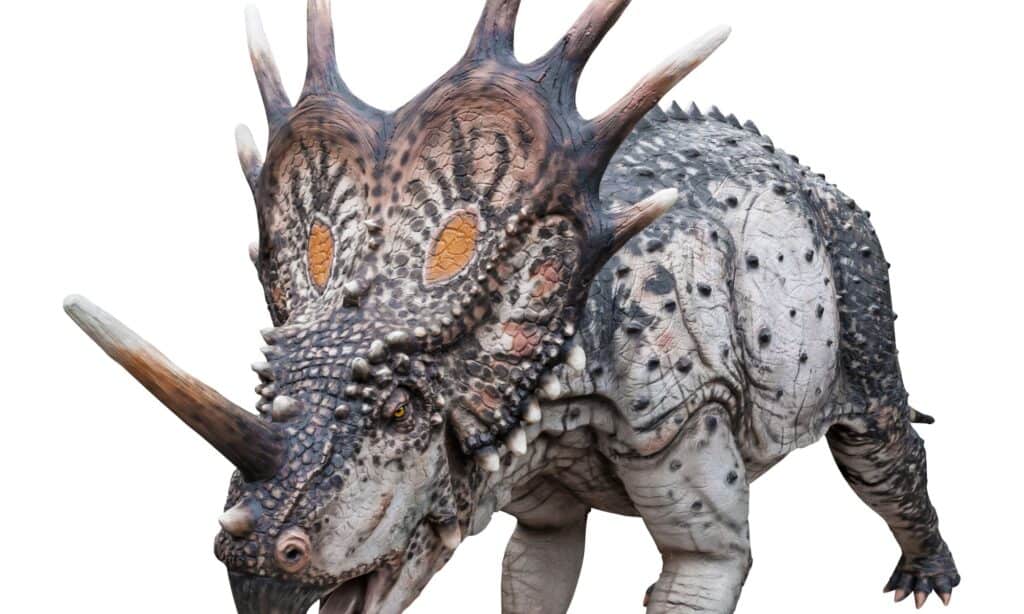
is a suborder of the
Ornithischiaorder of bird-hipped dinosaurs.
©YuRi Photolife/Shutterstock.com
Present in New Mexico during the Late Jurassic and Late Cretaceous periods, about 161 to 66 million years ago, Ceratopsia is a suborder of the Ornithischia order of bird-hipped dinosaurs. Translated as “horned faces,” Ceratopsia is one of the best-known dinosaurs in the world. Mainly thanks to their distinctive skull features – facial horns, frills, a large neck and chewing muscles, and the rostral bone. This bone is unique to this suborder and manifests as an edentulous ossification on the tip of the upper jaw.
They varied in size, to say the least. Some specimens could grow only up to 3 feet (1 m) long, while others could grow up to 30 feet (9 m) long; the latter also weighed up to 20,100 lbs (9,100 kg).
7. Bistahieversos
[Image needed. – Caption: The Bistahi destroyer is part of the Theropoda clade of hollow-boned dinosaurs.]

The Bistahi destroyer is part of the Theropoda clade of hollow-boned dinosaurs.
©590 × 359 pixels, file size: 17 KB, MIME type: image/jpeg – License
Present in New Mexico during the Late Cretaceous period, about 75.5 to 74.5 million years ago (a temporal range of only one million years). The Bistahi destroyer is part of the Theropoda clade of hollow-boned dinosaurs. A single species, B. sealeyi, discovered in New Mexico’s Fruitland and Kirtland formations, is attributed to the Bistahieversos genus.
Adult specimens grew up to 30 feet (9 m) long and weighed about a ton. These measurements were later re-estimated, with research suggesting that the genus was a little smaller (about 26 feet long) and heavier (about 2.75 short tons). Later, in 2016, the values were re-estimated, increasing once more by about 3 feet (1m) and about one short ton (1.2 metric tons).
8. Ornithopoda
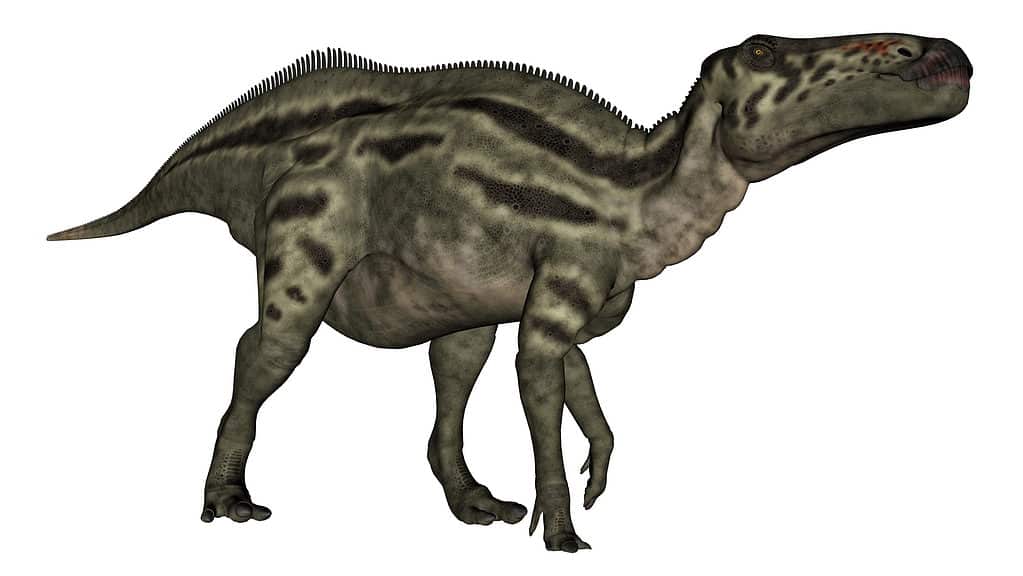
Ornithopods started their evolutionary period as bipedal grazers.
©Elenarts/Shutterstock.com
Present in New Mexico and North America during the Middle Jurassic and Late Cretaceous periods, about 164 to 66 million years ago, the ornithopods are a clade of the Ornithischia order of bird-hipped dinosaurs. Ornithopods started their evolutionary period as bipedal grazers. By the Cretaceous, the clade had grown in size from all points of view. Becoming a highly successful herbivore group (considered to have dominated the North American region).
The reason behind the clade’s fast evolution is its chewing apparatus. Characterized by progressive development, this apparatus was almost as good as or better than that of modern domestic cows. The chewing apparatus of the ornithopods is considered extremely sophisticated (at least for a non-avian dinosaur).
The largest ornithopods, represented by the Shantungosaurus, grew up to 50 feet (15 m) long and weighed about 25 short tons (23 metric tons).
Where to Find Fossils in New Mexico Today
Fossils can be seen in New Mexico in one of the state’s seven natural history museums. These are as follows: the Eastern New Mexico University Natural History Museum of Portales, the Las Cruces Museum of Natural History, the Mesalands Community College’s Dinosaur Museum of Tucumcari, the Miles Mineral Museum of Portales, the New Mexico Bureau of Geology and Mineral Resources Museum of Socorro, the New Mexico Museum of Natural History and Science of Albuquerque, and the Ruth Hall Museum of Paleontology of Abiquiú.
If you want to explore a fossil-filled area on your own (although being joined by a group is highly recommended), you should visit the San Juan Basin. Given that New Mexico is the 4th state in terms of dinosaur fossil volume, you’re bound to come across one.
Summary of 8 Dinosaurs that Lived in New Mexico
| Number | Dinosaur |
|---|---|
| 1 | Coelophysis |
| 2 | Allosaurus |
| 3 | Stegosaurus |
| 4 | Sauropoda |
| 5 | Tyrannosauroidea |
| 6 | Ceratopsia |
| 7 | Bistahieversos |
| 8 | Ornithopoda |
The photo featured at the top of this post is © Warpaint/Shutterstock.com
FAQs (Frequently Asked Questions)
Where can you see fossils in New Mexico?
Fossils can be seen in New Mexico in one of the state’s seven natural history museums. These are as follows: the Eastern New Mexico University Natural History Museum of Portales, the Las Cruces Museum of Natural History, the Mesalands Community College’s Dinosaur Museum of Tucumcari, the Miles Mineral Museum of Portales, the New Mexico Bureau of Geology and Mineral Resources Museum of Socorro, the New Mexico Museum of Natural History and Science of Albuquerque, and the Ruth Hall Museum of Paleontology of Abiquiú.
Where might one go to discover a fossil of their own?
If you want to explore a fossil-filled area on your own (although being joined by a group is highly recommended), you should visit the San Juan Basin.
Thank you for reading! Have some feedback for us? Contact the AZ Animals editorial team.






